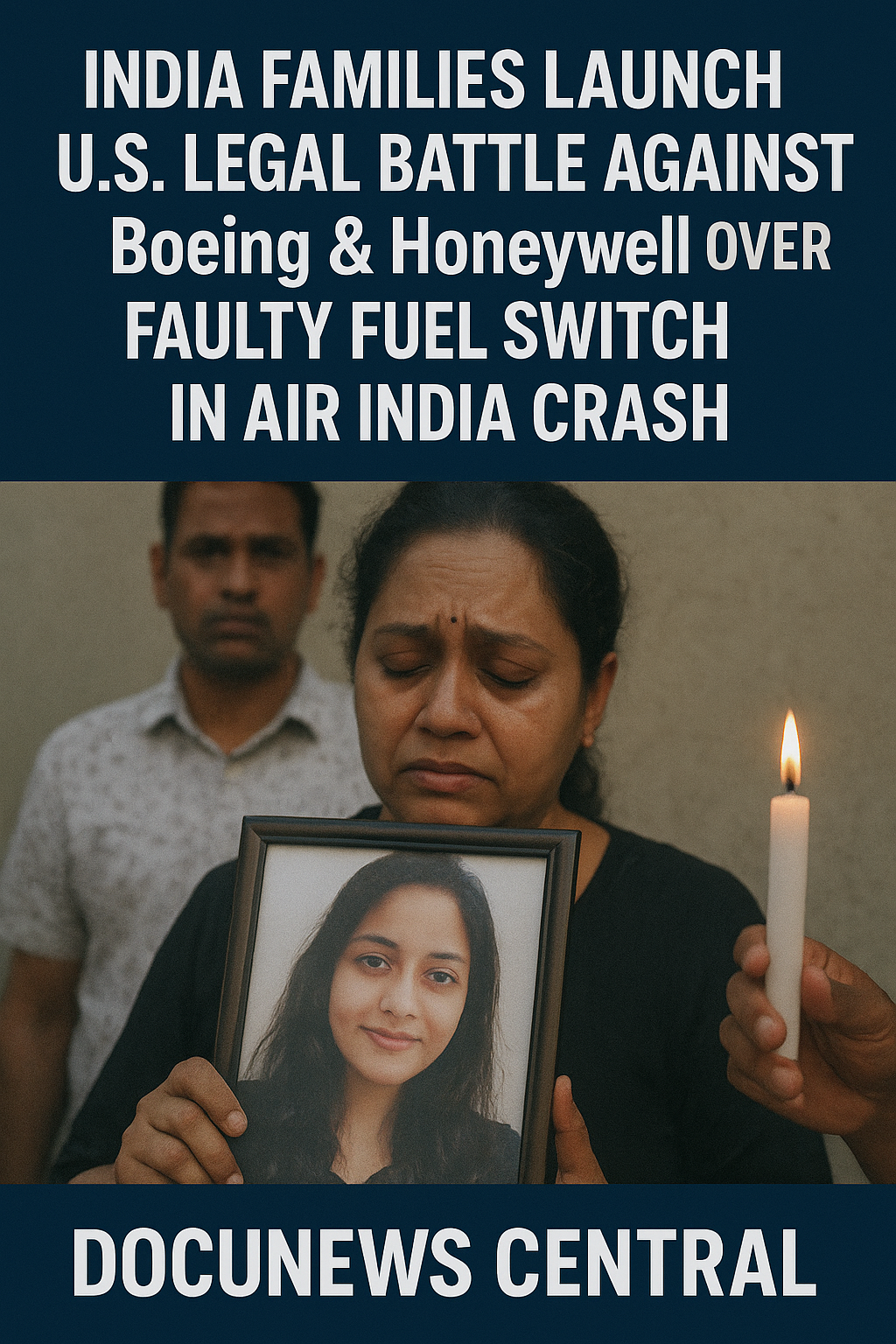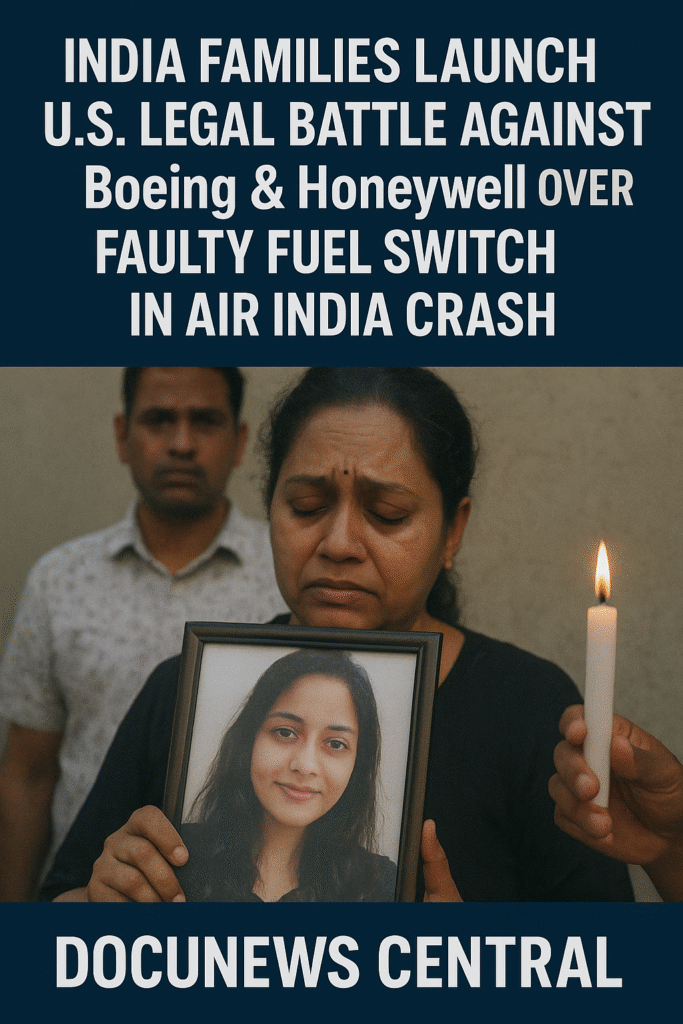

India Families Launch U.S. Legal Battle Against Boeing & Honeywell Over Faulty Fuel Switch in Air India Crash
The families of four victims killed in the Air India Flight 171 disaster have filed a lawsuit in the United States.
The complaint centers on allegedly defective fuel cutoff switches in a Boeing 787.
They blame Boeing and Honeywell for negligence that cost 260 lives.
DocuNews Central brings you the full story.
Details of the Lawsuit and Claims
On 17 September 2025, relatives of four passengers filed a lawsuit in the Delaware Superior Court.
Plaintiffs include families of Kantaben Dhirubhai Paghadal, Naavya Chirag Paghadal, Kuberbhai Patel, and Babiben Patel.
They allege that fuel cutoff switches, designed by Honeywell and installed by Boeing, were prone to accidental activation.
The switches are asserted to reside just behind thrust levers, making inadvertent movement possible during routine cockpit activity.
Call to Action: Keep Reading DocuNews Central for unbiased updates as this case unfolds.
FAA Advisory and Alleged Non-Compliance
In 2018, the U.S. Federal Aviation Administration issued an advisory (not mandatory) about certain Boeing fuel cutoff switches.
That advisory warned that locking mechanisms on some switches could be disengaged.
According to the lawsuit, Boeing and Honeywell knew of the risk but did not ensure all operators inspected or replaced potentially defective units.
Preliminary AAIB Findings & Cockpit Voice Recording
India’s Aircraft Accident Investigation Bureau (AAIB) issued preliminary reports in July.
They found that soon after takeoff both switches moved from “RUN” to “CUTOFF.”
The engines lost thrust; the plane crashed less than a minute after liftoff from Ahmedabad.
The cockpit voice recorder captured one pilot asking, “Why did you cut off fuel?” and the other replying, “I did not do so.”
Statements from Family and Legal Counsel
Pushkaraj Sabharwal, father of Captain Sumeet Sabharwal, demanded a formal investigation by the Indian government. He objected to what he termed “selective leaks” that he says damage his son’s reputation.
Benjamin Major of The Lanier Law Firm, representing the families, said:
“It is shocking that Honeywell and Boeing both knew of this danger and did absolutely nothing to prevent the inevitable catastrophe that occurred on June 12.”
He added:
“This defect is comparable to an auto manufacturer putting an unprotected emergency brake control next to a radio volume knob in your car. And unlike a car, restarting jet engines takes minutes, not seconds.”
Regulatory & Expert Reactions
FAA Administrator Bryan Bedford stated he has “a high level of confidence” that neither mechanical failure nor an unintended movement of fuel control components caused the crash.
However, some aviation safety experts disagree, highlighting that the placement of switches behind thrust levers makes them vulnerable during high-stress phases of flight.
Regulators in India, including the DGCA, have already ordered inspections of fuel cutoff switches on Boeing 787s and 737s after the AAIB preliminary report.
Legal Arguments & Potential Liability
The lawsuit accuses Boeing and Honeywell of product defect and negligence.
It claims they knew the locking mechanism was sometimes missing or disengaged, yet did not warn operators or ship replacement parts.
Plaintiffs seek compensatory and punitive damages for wrongful deaths.
Questions Raised and Unresolved Issues
Was the switch movement accidental, human error, or mechanical defect?
Why were the FAA advisory recommendations not followed by all operators?
Were maintenance records complete, especially for the throttle control module replacements in 2019 and 2023?
Impact on Boeing, Honeywell, & Industry Standards
Boeing has declined to comment beyond public statements pointing to AAIB’s investigation.
Honeywell has not yet responded to public inquiries.
A successful lawsuit could establish stronger liability norms for component design and disclosure. It might push regulatory bodies to convert advisory notices into binding requirements.
Call for Transparency & Next Steps
Families and legal counsel are demanding full transparency from manufacturing companies. They insist all internal documents, design specs, and email warnings be made public.
They want regular updates from AAIB and DGCA, and an independent review of cockpit procedures.
Call to Action: Subscribe to DocuNews Central for live updates, original reporting, and expert analysis as these proceedings advance.
Public Trust, Pilot Rights, and Reputation
Captain Sumeet Sabharwal’s family strongly contests any suggestion of misconduct on his part.
Pushkaraj Sabharwal emphasised that his son held over 15,600 flying hours, including thousands on the 787‐8 Dreamliner.
He rejected claims that personal tragedies or psychological issues could have influenced the pilot’s behavior.
Final Note: The Road Ahead
As the case proceeds in U.S. courts, all eyes are on whether Boeing and Honeywell will disclose internal design history.
India’s aviation regulators face a pivotal moment. Their decisions now may shape future aircraft safety laws.
DocuNews Central will continue providing detailed coverage. You can stay informed by following our updates and subscribing.
This is DocuNews Central Reporting.








